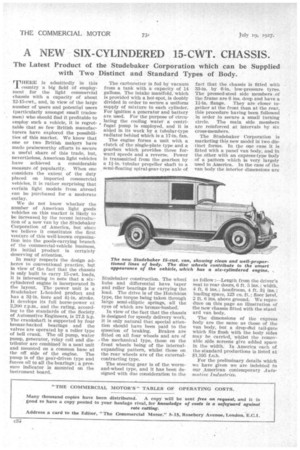A NEW• SIX-CYLINDERED 15-CWT. CHASSIS.
Page 60

If you've noticed an error in this article please click here to report it so we can fix it.
The Latest Product of the Studebaker Corporation which can be Supplied with Two Distinct and Standard Types of Body.
TdERE is admittedly in this country a big field of employment for the light commercial chassis with a capacity of about 12-15-cwt., and, in view of the large number of users and potential users (particularly amongst small tradesmen) who should find it profitable to employ such a vehicle, it is regret. .table that So few British manufacturers have explored the possibilities of this market. We know that one or two British makers have made praiseworthy efforts to secure a useful share of this trade, but, nevertheless, American light vehicles have achieved a considerable measure of popularity. When one considers the extent of the duty placed on imported commercial vehicles, it is rather surprising that certain light models from abroad can be purchased for a moderate outlay.
We do not know whether the number of American -light goods vehicles on this market is likely to be increased by the recent introduction of a new van by the Studebaker Corporation of America, but since we believe it constitutes the first venture of this well-known organization into the goods-carrying branch of the commercial-vehicle business, its initial product is certainly deserving of attention.
In many respects the design adheres to conventional practice, but in view of the fact that the chassis is only built to carry 15-cwt. loads, it is interesting to note that a sixcylindereil engine is incorporated in the layout. The power unit is a Studebaker L-headed product and has a 31-in. bore and 4i-in. stroke. it develops its full horse-power at 2,200 r.p.m., and the rating, according to the standards of the Society of Automotive Engineers, is 27.3 h.p. The crankshaft is supported by four bronze-backed bearings and the valves are operated by a roller type of bell crank. The oil pump, water pump, generator, relay coil and distributor are combined' in a neat unit and mounted on a common base at the off. side of the engine. The pump is of the gear-driven type and forces oil to all the bearings; a pressure indicator is mounted on the instrument board.
The carburetter is fed by vacuum from a tank with a capacity of 14 gallons. The intake manifold, which is provided with a hot-spot, is doubly divided in order to secure a uniform supply of mixture to each cylinder. For ignition a generator and battery are used. For the purpose of circulating the cooling water a centrifugal pump is employed, and it is aided in its work by a tubular-type radiator behind which is a 17-in. fan.
The engine forms a unit with a clutch of the single-plate type and a gearbox which provides three forward speeds and a reverse. Power is transmitted from the gearbox by a Win, tubular propeller shaft to a semi-floating spiral-gear-type axle of Studebaker construction. The wheel hubs and differential have taper and roller bearings for carrying the load. The drive is of the Hotchkiss type, the torque being taken through large semi-elliptic springs, all the eyes of which are bronze-bushed.
In view of the fact that the chassis is designed for speedy delivery work, it is only natural that special attention should have been paid to the question of braking. Brakes are fitted on all four wheels and are of , the mechanical type, those on the front wheels being of the internalexpanding pattern, whilst those on the rear wheels are of the externalcontracting type.
The steering gear is of the wormand-wheel type, and it has been designed with due consideration to the fact that the chassis is fitted with 33-in. by 6-in, low-pressure tyres. The pressed-steel side members of the frame are 6 ins, deep and have a flange. They are closer together at the front than at the rear, this procedure having been followed in order to secure a small turning circle. The main side members are reinforced at intervals by six cross-members.
The Studebaker Corporation is Marketing this new model in two distinct forms. In the one case it is fitted with a panel' van body, and in the other with an express-type body of a pattern which is very largely used in America. In the case of the van body the interior dimensions are as follow :—Length from the driver's seat to rear doors, 6 ft. 5 ins. ; width, 4 ft. 6 ins.; headroom, 4 ft. 3i ins.; loading space, 123 cu.ft.; floor level, 2 ft. 6 ins, above ground. We reproduce on this page an illustration of the new chassis fitted with the stand ard van body.
The dimensions of the express body are the same as those of the van body, but a drop-dnd tail-gate which fits flush with the body sides may be carried, whilst the removable side screens give added space in the width. In America each of the standard productions is listed at $1,195 f.o.b.
For the preliminary details which we have given we are indebted to our American contemporary _Automotive industries.












































































































